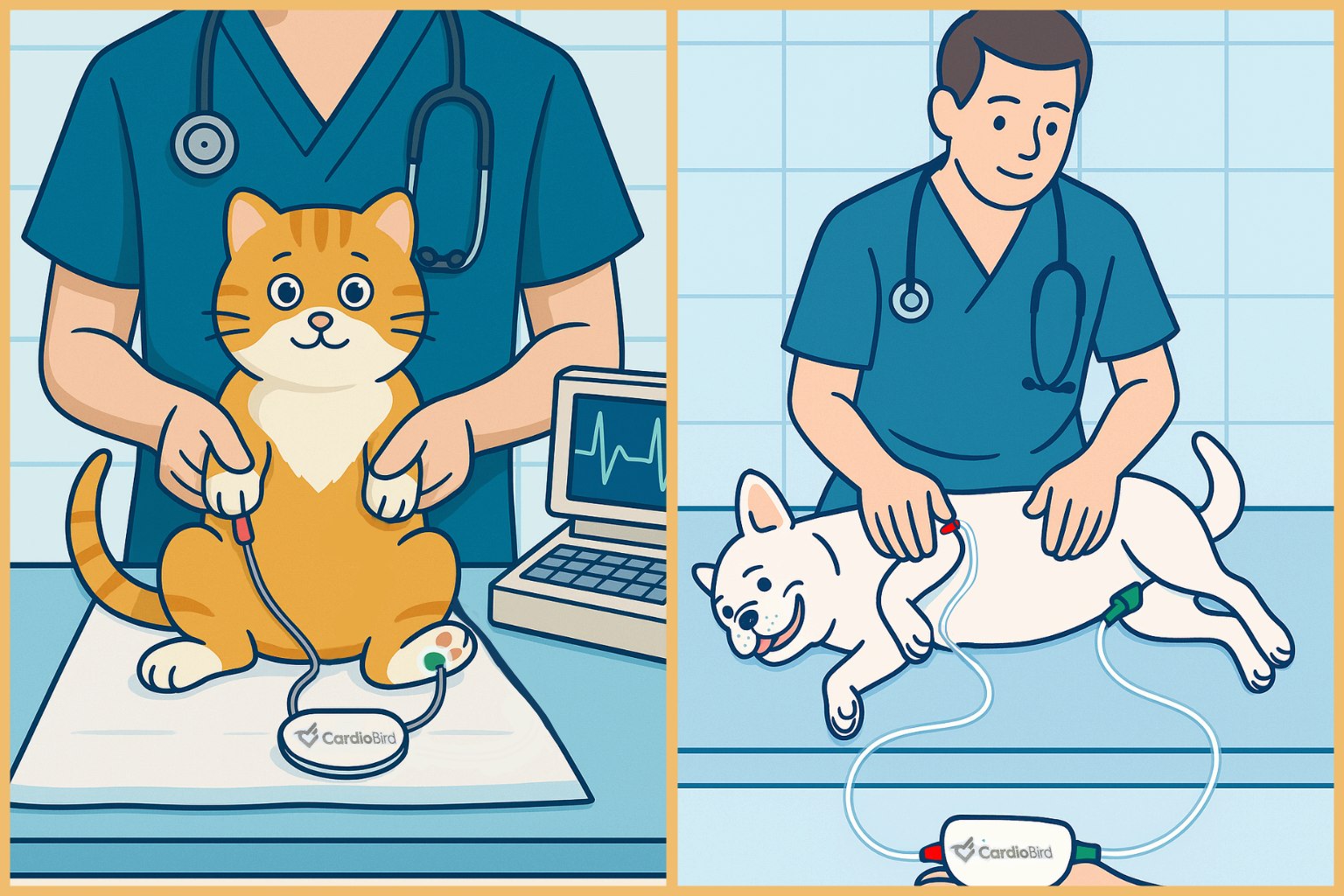The Indispensable Role of ECG in Diagnosing and Monitoring Common Canine and Feline Heart Diseases

Estimated reading time: 5.48 minutes
Welcome to the seventh issue of the CardioBird newsletter! As veterinarians, you are on the front lines of pet healthcare, and identifying cardiac disease early and accurately is crucial for improving patient outcomes. While a comprehensive cardiac workup involves multiple diagnostic tools, the electrocardiogram (ECG) remains a cornerstone for assessing arrhythmia and detecting abnormalities indicative of common heart conditions. With innovative solutions like CardioBird, integrating ECG into your daily practice has never been easier or more insightful.
This article will delve into the specific ECG findings associated with common canine and feline heart diseases like Myxomatous Mitral Valve Disease (MVD), Dilated Cardiomyopathy (DCM), and Hypertrophic Cardiomyopathy (HCM). We’ll explore how ECG aids in diagnosis, monitors disease progression in conjunction with other tests, and provides disease-specific insights, reinforcing its clinical relevance in both diagnosis and treatment evaluation.
The Power of the Electrical Pulse: What Your ECG Reveals
An ECG records the electrical activity of the heart, providing a graphical representation of the depolarization and repolarization of the atria and ventricles. This allows for the assessment of:
- Heart Rate: Detecting tachycardia or bradycardia.
- Heart Rhythm: Identifying arrhythmias such as atrial fibrillation, ventricular premature complexes (VPCs), or conduction disturbances.
- Chamber Enlargement: Suggestive findings like tall P waves (P pulmonale) for right atrial enlargement, wide P waves (P mitrale) for left atrial enlargement, or tall R waves and widened QRS complexes for ventricular enlargement, although these are often less specific without other correlating findings.
- Myocardial or Pericardial Disease: Changes in ST segments or reduced QRS voltages with electrical alternans can sometimes suggest ischemia or pericardial effusion, although these are often less specific without other correlating findings.
ECG Insights in Common Canine Heart Diseases
1.Myxomatous Mitral Valve Disease (MVD)
MVD is the most commonly acquired heart disease in dogs, particularly affecting small to medium-sized breeds. As the mitral valve degenerates, it leads to regurgitation, volume overload, and progressive left heart enlargement.
- Specific ECG Findings:
- P mitrale (widened P wave >0.04s in dogs): Suggestive of left atrial enlargement.
- Increased QRS duration (e.g., >0.05s in small dogs, >0.06s in large dogs): May indicate left ventricular enlargement.
- Tall R waves: Also associated with left ventricular enlargement.
- Arrhythmias: Supraventricular premature complexes (APCs), ventricular premature complexes (VPCs), and atrial fibrillation (often in advanced stages) are common.
- Sinus tachycardia: A common compensatory mechanism.
- Role in Diagnosis and Monitoring:
- While echocardiography is the gold standard for diagnosing MVD and assessing its severity, ECG is invaluable for detecting arrhythmias that can significantly impact prognosis and treatment decisions.
- Serial ECGs can help monitor for the development or worsening of arrhythmias and assess the response to anti-arrhythmic therapy.
- The presence of arrhythmias like atrial fibrillation often indicates advanced disease and may necessitate adjustments in treatment protocols.
2.Dilated Cardiomyopathy (DCM)
DCM is a primary myocardial disease characterized by ventricular dilation and systolic dysfunction, predominantly affecting large and giant breed dogs.
- Specific ECG Findings:
- Atrial fibrillation: This is a common arrhythmia in dogs with DCM and can be a presenting sign.
- Ventricular premature complexes (VPCs) and Ventricular Tachycardia: These are also frequently observed and can increase the risk of sudden death.
- Widened QRS complexes and increased R wave amplitude: Consistent with left ventricular dilation and hypertrophy (though hypertrophy is eccentric).
- P mitrale: Indicating left atrial enlargement.
- ST segment depression or elevation: Can be seen but are not specific for DCM.
- Role in Diagnosis and Monitoring:
- ECG is critical for identifying the life-threatening arrhythmias commonly associated with DCM. Holter monitoring (a 24-hour ECG) is often recommended for assessing arrhythmia burden and guiding anti-arrhythmic therapy.
- While echocardiography confirms the diagnosis of DCM, ECG provides crucial information about the electrical instability of the heart.
- Monitoring ECG changes is essential for evaluating the efficacy of anti-arrhythmic medications and managing symptomatic patients.
ECG Insights in Common Feline Heart Diseases
1.Hypertrophic Cardiomyopathy (HCM) phenotype
HCM phenotype is the most prevalent cardiac disease in cats, characterized by left ventricular hypertrophy, in conjunction with multiple factors.
- Specific ECG Findings:
- Left anterior fascicular block (LAFB) or left bundle branch block (LBBB)†: These conduction abnormalities can be seen due to ventricular hypertrophy and fibrosis, leading to a left axis deviation.
- Increased QRS duration and amplitude (tall R waves): Suggestive of left ventricular hypertrophy.
- Arrhythmias: VPCs, atrial fibrillation (less common than in canine DCM but can occur), and ventricular tachycardia can be present.
- P mitrale: May be seen with left atrial enlargement.
- ST segment changes: Can occur but are often non-specific.
†Lead II ECG alone can be very helpful in raising suspicion for LBBB if it detects a significantly widened QRS complex. Yet, 6-lead or 12 lead ECG is required to make a definite diagnosis of LBBB. Diagnosing LAFB reliably requires a multi-lead ECG to assess frontal plane axis and specific QRS morphologies in those leads. A single-lead ECG is not designed to diagnose LAFB directly.
- Role in Diagnosis and Monitoring:
- ECG findings like LAFB and tall R waves can increase the suspicion of HCM, prompting further investigation with echocardiography.
- Detection of arrhythmias is crucial, as they can contribute to clinical signs and increase the risk of adverse outcomes like arterial thromboembolism or sudden death.
- ECG helps in monitoring response to medications aimed at controlling heart rate or arrhythmias.
ECG: A Key Player in a Multimodal Diagnostic Approach
It’s important to emphasize that ECG provides unique information about the heart’s electrical system that other tests, like radiography (which shows cardiac silhouette and pulmonary vasculature) and echocardiography (which assesses cardiac structure, function, and blood flow), do not.
- Complementary Information: ECG findings, when interpreted alongside physical examination, thoracic radiographs, and echocardiography, contribute to a more complete understanding of the patient’s cardiac status.
- Screening: ECG can be a useful initial screening tool, especially when arrhythmias are suspected based on auscultation or clinical signs.
- Anesthesia Monitoring: Continuous ECG monitoring is vital during anesthesia, particularly in patients with known or suspected heart disease, to detect and manage any emergent arrhythmias.
- Treatment Evaluation: ECG is indispensable for treatment outcome evaluation, especially to anti-arrhythmic therapies and medications that can affect cardiac conduction or rhythm.
The CardioBird Advantage in Your Practice
CardioBird ECG solution is designed to streamline the integration of ECG into your busy primary care workflow. CardioBird AI can help in the rapid and accurate identification of common arrhythmias and suggestive patterns of chamber enlargement, providing you with actionable insights quickly. This allows for more confident decision-making, timely referrals when needed, and enhanced patient care.
Conclusion: Embracing ECG for Enhanced Cardiac Care
The ECG is a non-invasive, cost-effective, and invaluable tool in the diagnosis and management of common canine and feline heart diseases. By understanding specific ECG findings associated with conditions like MVD, primary DCM, and HCM phenotype,and by integrating ECG with other diagnostic modalities, veterinarians can significantly enhance their ability to detect cardiac disease early, monitor its progression, and evaluate treatment outcomes. CardioBird is committed to supporting you in this endeavor, providing advanced yet user-friendly ECG technology to elevate the standard of cardiac care in your practice.
References:
- Tilley, L. P., & Smith, F. W. K. (2016). Blackwell’s Five-Minute Veterinary Consult: Canine and Feline (6th ed.). Wiley-Blackwell. (General reference for ECG findings)
- Keene, B. W., Atkins, C. E., Bonagura, J. D., Fox, P. R., Häggström, J., Fuentes, V. L., … & Sederholm, T. (2019). ACVIM consensus guidelines for the diagnosis and treatment of myxomatous mitral valve disease in dogs. Journal of Veterinary Internal Medicine, 33(3), 1127-1140.
- Dukes-McEwan, J., Borgarelli, M., Tidholm, A., Vollmar, A. C., & Häggström, J. (2003). Proposed guidelines for the diagnosis of canine idiopathic dilated cardiomyopathy. Journal of Veterinary Cardiology, 5(2), 7-19.
- Ferasin, L., Sturgess, C. P., Cannon, M. J., Caney, S. M. A., & Gruffydd-Jones, T. J., Wotton, P. R. (2003). Feline idiopathic cardiomyopathy: a retrospective study of 106 cats (1994-2001). Journal of Feline Medicine and Surgery, 5(3), 151-159.
- Payne, J. R., Borgeat, K., Brodbelt, D. C., Connolly, D. J., & Luis Fuentes, V. (2015). Risk factors associated with sudden death vs. congestive heart failure or arterial thromboembolism in cats with hypertrophic cardiomyopathy. Journal of Veterinary Cardiology, 17, S318-S328.
- Bonagura, J. D., & Twedt, D. C. (Eds.). (2014). Kirk’s Current Veterinary Therapy XV. Elsevier Health Sciences. (General reference for the role of ECG in a multimodal approach)

